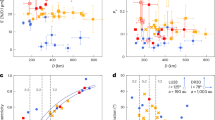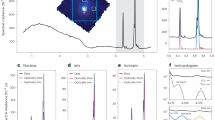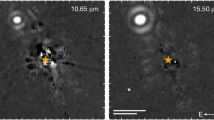Abstract
Centaurs are small bodies orbiting between Jupiter and Neptune and behave as an intermediate population between trans-Neptunian-belt objects and Jupiter-family comets. As such, their surface composition and evolutionary processes are key to understanding the Solar System’s history. However, the mechanisms driving their transformation and the impact of thermal processing on their surfaces remain open questions. Here we examined the surface properties of five Centaurs using the James Webb Space Telescope near-infrared spectrograph reflectance spectra (0.6–5.3 μm). They exhibit considerable diversity in surface composition. Our analysis indicates that Centaurs can be split into two main categories, which is also observed for trans-Neptunian objects: one group has surfaces composed of refractory materials with some water ice, whereas the other is dominated by carbon-based materials. Additionally, two of the five objects have primarily refractory surfaces with minimal volatiles, suggesting a high concentration of primitive, comet-like dust. We suggest that the observed Centaur surfaces reflect their transitional states, as they are shifting from being ice-rich bodies to progressively becoming more dominated by non-volatile materials as they approach the Sun. Such thermal processing may have changed the surface properties of other similar Solar System bodies, like comets, Jupiter trojans and D-type asteroids.
This is a preview of subscription content, access via your institution
Access options
Access Nature and 54 other Nature Portfolio journals
Get Nature+, our best-value online-access subscription
$32.99 / 30 days
cancel any time
Subscribe to this journal
Receive 12 digital issues and online access to articles
$119.00 per year
only $9.92 per issue
Buy this article
- Purchase on SpringerLink
- Instant access to full article PDF
Prices may be subject to local taxes which are calculated during checkout




Similar content being viewed by others
Data availability
The JWST data used in this analysis are publicly available from the STScI MAST Archive (https://mast.stsci.edu/portal/Mashup/Clients/Mast/Portal.html).
References
Gladman, B., Marsden, B. G. & Vanlaerhoven, C. in The Solar System Beyond Neptune (eds Barucci, M. A. et al.) 43–57 (Univ. Arizona Press, 2008).
Fernandez, J. A. On the existence of a comet belt beyond Neptune. Mon. Not. R. Astron. Soc. 192, 481–491 (1980).
Levison, H. F. & Duncan, M. J. From the Kuiper belt to Jupiter-family comets: the spatial distribution of ecliptic comets. Icarus 127, 13–32 (1997).
Nesvorný, D. et al. Origin and evolution of short-period comets. Astrophys. J. 845, 27 (2017).
Pinilla-Alonso, N. et al. A JWST/DiSCo-TNOs portrait of the primordial Solar System through its trans-Neptunian objects. Nat. Astron. https://doi.org/10.1038/s41550-024-02433-2 (in the press).
Closs, M. F. et al. The integral field unit on the James Webb Space Telescope’s near-infrared spectrograph. In Proc. SPIE Conference Series, Space Telescopes and Instrumentation 2008: Optical, Infrared, and Millimeter Vol. 7010 (eds Oschmann, J. et al.) 701011 (SPIE, 2008).
Böker, T. et al. The near-infrared spectrograph (NIRSpec) on the James Webb Space Telescope. III. Integral-field spectroscopy. Astron. Astrophys. 661, A82 (2022).
De Prá, M. N. et al. Widespread CO2 and CO ices in the trans-Neptunian population revealed by JWST/DiSCo-TNOs. Nat. Astron. https://doi.org/10.1038/s41550-024-02276-x (2024).
Nesvorný, D. et al. OSSOS XX: the meaning of Kuiper belt colors. Astron. J. 160, 46 (2020).
Pirani, S., Johansen, A. & Mustill, A. J. How the formation of Neptune shapes the Kuiper belt. Astron. Astrophys. 650, A161 (2021).
Marsset, M. et al. Col-OSSOS: evidence for a compositional gradient inherited from the protoplanetary disk? Planet. Sci. J. 4, 160 (2023).
Gil-Hutton, R. Color diversity among Kuiper belt objects: the collisional resurfacing model revisited. Planet. Space Sci. 50, 57–62 (2002).
Jewitt, D. The active centaurs. Astron. J. 137, 4296–4312 (2009).
Guilbert-Lepoutre, A. Survival of amorphous water ice on centaurs. Astron. J. 144, 97 (2012).
Barkume, K. M., Brown, M. E. & Schaller, E. L. Near-infrared spectra of centaurs and Kuiper belt objects. Astron. J. 135, 55–67 (2008).
Cruikshank, D. P. et al. The composition of centaur 5145 Pholus. Icarus 135, 389–407 (1998).
Raponi, A. et al. Infrared detection of aliphatic organics on a cometary nucleus. Nat. Astron. 4, 500–505 (2020).
Bernardinelli, P. H. et al. C/2014 UN271 (Bernardinelli–Bernstein): the nearly spherical cow of comets. Astrophys. J. Lett. 921, L37 (2021).
Kelley, M. S. P. et al. A look at outbursts of comet C/2014 UN271 (Bernardinelli–Bernstein) near 20 au. Astrophys. J. Lett. 933, L44 (2022).
Hui, M.-T., Farnocchia, D. & Micheli, M. C/2010 U3 (Boattini): a bizarre comet active at record heliocentric distance. Astron. J. 157, 162 (2019).
Hui, M.-T., Jewitt, D. & Clark, D. Pre-discovery observations and orbit of comet C/2017 K2 (PANSTARRS). Astron. J. 155, 25 (2018).
Bolin, B. et al. Multi-cycle monitoring of the volatile evolution of a returning planetesimal as it approaches perihelion. Space Telescope Science Institute https://www.stsci.edu/jwst/science-execution/program-information?id=4198 (2023).
Davidsson, B. J. R. Thermophysical evolution of planetesimals in the primordial disc. Mon. Not. R. Astron. Soc. 505, 5654–5685 (2021).
Gkotsinas, A., Guilbert-Lepoutre, A., Raymond, S. N. & Nesvorny, D. Thermal processing of Jupiter-family comets during their chaotic orbital evolution. Astrophys. J. 928, 43 (2022).
Lisse, C. M. et al. A predicted dearth of majority hypervolatile ices in Oort cloud comets. Planet. Sci. J. 3, 112 (2022).
Parhi, A. & Prialnik, D. Sublimation of ices during the early evolution of Kuiper belt objects. Mon. Not. R. Astron. Soc. 522, 2081–2088 (2023).
Wooden, D. H., Ishii, H. A. & Zolensky, M. E. Cometary dust: the diversity of primitive refractory grains. Philos. Trans. R. Soc. Lond. Ser. A 375, 20160260 (2017).
Martin, A. C. & Emery, J. P. MIR spectra and analysis of Jovian trojan asteroids. Planet. Sci. J. 4, 153 (2023).
Filacchione, G. et al. Comet 67P/CG nucleus composition and comparison to other comets. Space Sci. Rev. 215, 19 (2019).
Kelley, M. S. P. et al. Spectroscopic identification of water emission from a main-belt comet. Nature 619, 720–723 (2023).
Tegler, S. C. & Romanishin, W. Two distinct populations of Kuiper-belt objects. Nature 392, 49–51 (1998).
Peixinho, N. et al. Reopening the TNOs color controversy: centaurs bimodality and TNOs unimodality. Astron. Astrophys. 410, L29–L32 (2003).
Jewitt, D. The trojan color conundrum. Astron. J. 155, 56 (2018).
Shkuratov, Y., Starukhina, L., Hoffmann, H. & Arnold, G. A model of spectral albedo of particulate surfaces: implications for optical properties of the Moon. Icarus 137, 235–246 (1999).
Mastrapa, R. M. et al. Optical constants of amorphous and crystalline H2O-ice in the near infrared from 1.1 to 2.6 μm. Icarus 197, 307–320 (2008).
Mastrapa, R. M., Sandford, S. A., Roush, T. L., Cruikshank, D. P. & Dalle Ore, C. M. Optical constants of amorphous and crystalline H2O-ice: 2.5–22 μm (4000–455 cm−1) optical constants of H2O-ice. Astrophys. J. 701, 1347–1356 (2009).
Peixinho, N., Delsanti, A. & Doressoundiram, A. Reanalyzing the visible colors of centaurs and KBOs: what is there and what we might be missing. Astron. Astrophys. 577, A35 (2015).
Bauer, J. M. et al. Centaurs and scattered disk objects in the thermal infrared: analysis of WISE/NEOWISE observations. Astrophys. J. 773, 22 (2013).
Duffard, R. et al. ‘TNOs are cool’: a survey of the trans-Neptunian region. XI. A Herschel-PACS view of 16 centaurs. Astron. Astrophys. 564, A92 (2014).
Baratta, G. & Palumbo, M. Infrared optical constants of CO and CO2 thin icy films. J. Opt. Soc. Am. A 15, 3076–3085 (1998).
Khare, B. N. et al. Optical constants of organic tholins produced in a simulated Titanian atmosphere: from soft X-ray to microwave frequencies. Icarus 60, 127–137 (1984).
Dorschner, J., Begemann, B., Henning, T., Jaeger, C. & Mutschke, H. Steps toward interstellar silicate mineralogy. II. Study of Mg-Fe-silicate glasses of variable composition. Astron. Astrophys. 300, 503 (1995).
Acknowledgements
The DiSCo-TNOs team would like to thank W. Eck and A. Henry of the Space Telescope Science Institute for their help in preparing the observations for execution. This work is based on observations made with the NASA/ESA/CSA JWST under the GO-1 programme 2418. Support for this programme was provided by NASA through a grant from the Space Telescope Science Institute. The data were obtained from the Mikulski Archive for Space Telescopes at the Space Telescope Science Institute, which is operated by the Association of Universities for Research in Astronomy, Inc., under NASA contract NAS 5-03127 for JWST. J.L. acknowledges support from the Agencia Estatal de Investigación del Ministerio de Ciencia e Innovación (Grant ‘Hydrated Minerals and Organic Compounds in Primitive Asteroids’, Ref. PID2020-120464GB-100). N.P. acknowledges funding from Fundação para a Ciência e a Tecnologia (Research Grant Nos. UIDB/04434/2020 and UIDP/04434/2020). R.B. and E.H. acknowledge support from CNES-France (JWST mission). A.G.-L. received funding from the European Research Council under the European Union’s Horizon 2020 research and innovation programme (Grant Agreement No. 802699). J.A.S. acknowledges Lowell Observatory and Northern Arizona University, both in Flagstaff, AZ, for support during his sabbatical tenure there.
Author information
Authors and Affiliations
Contributions
J.L., N.P.-A., V.L., M.N.D.P., B.J.H. and J.A.S. designed the observational programme. N.P.-A., M.N.D.P., R.B., J.L., Y.J.P., D.P.C., B.J.H., T.M., J.A.S. and J.P.E. conceived the science goals of DiSCo. J.L. and N.P.-A. conceived in particular the goals related to Centaurs. B.J.H., N.P.-A., I.W., A.C.d.S.F., M.N.D.P. and C.A.S. reduced and validated the data. J.L., N.P.-A., E.H., R.B., M.N.D.P., A.C.d.S.F., J.A.S. and T.M. performed the band identification and spectral characterization. R.B., M.N.D.P. and N.P.-A. performed the clustering and the study of the band areas. J.L., R.B., N.P.-A. and A.G.-L. elaborated on and proposed the scenario for interpreting the results. J.L. and N.P.-A. drafted the paper. All authors were involved in the discussion of the results and the finalization of the paper.
Corresponding author
Ethics declarations
Competing interests
The authors declare no competing interests.
Peer review
Peer review information
Nature Astronomy thanks Theodore Kareta and the other, anonymous, reviewer(s) for their contribution to the peer review of this work.
Additional information
Publisher’s note Springer Nature remains neutral with regard to jurisdictional claims in published maps and institutional affiliations.
Extended data
Extended Data Fig. 1 Reflectance spectra of the five Centaurs presented in this paper.
Reflectance spectra of the five Centaurs presented in this paper shifted in the y-axis by 1.0. In red is represented the Centaur with a Cliff-type spectrum defined in5, in blue those with a Bowl-type spectrum, and in green the two ones that belong to a spectral class that is unique between the Centaurs. Error bars (computed as the standard deviation of the four dithered exposures of each target) are shown in light-grey.
Rights and permissions
Springer Nature or its licensor (e.g. a society or other partner) holds exclusive rights to this article under a publishing agreement with the author(s) or other rightsholder(s); author self-archiving of the accepted manuscript version of this article is solely governed by the terms of such publishing agreement and applicable law.
About this article
Cite this article
Licandro, J., Pinilla-Alonso, N., Holler, B.J. et al. Thermal evolution of trans-Neptunian objects through observations of Centaurs with JWST. Nat Astron 9, 245–251 (2025). https://doi.org/10.1038/s41550-024-02417-2
Received:
Accepted:
Published:
Issue date:
DOI: https://doi.org/10.1038/s41550-024-02417-2
This article is cited by
-
Water ice in the debris disk around HD 181327
Nature (2025)
-
The Origins & Reservoirs of Exocomets
Space Science Reviews (2025)
-
A JWST/DiSCo-TNOs portrait of the primordial Solar System through its trans-Neptunian objects
Nature Astronomy (2024)



